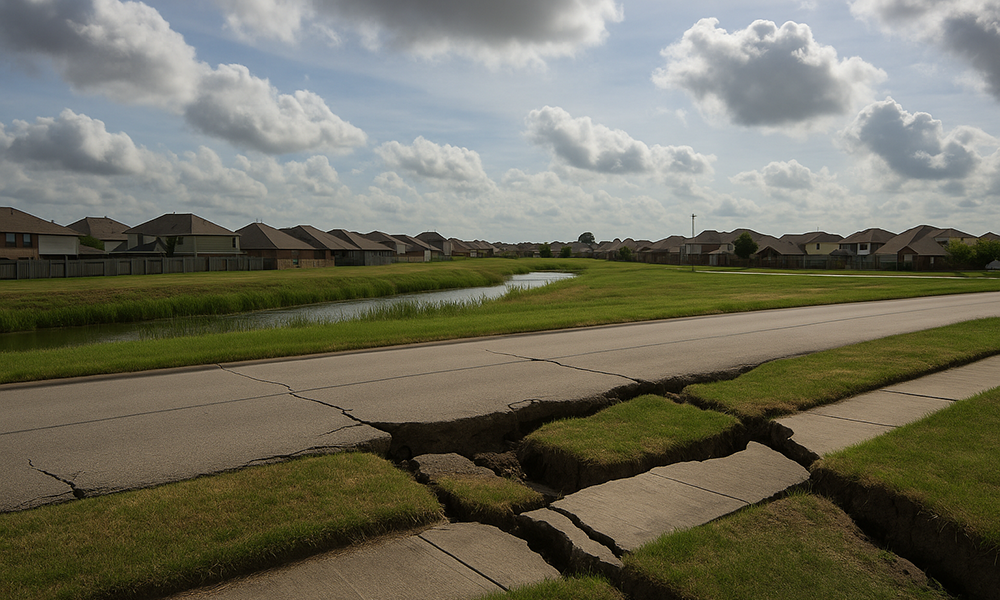
Stop the Sinking: What NFBWA Residents Need to Know About Water Subsidence
Imagine your neighborhood slowly sinking. It’s not a sci-fi scenario—it’s a real phenomenon called subsidence, and it’s happening in regions like North Fort Bend County. While the North Fort Bend Water Authority (NFBWA) is working diligently to protect our communities, residents also play a vital role in preventing future damage. Here's what you need to know—and what you can do to help.
What Is Subsidence?
Subsidence is the gradual sinking of the land’s surface over time. It typically occurs when too much groundwater is pumped from underground aquifers. As water is withdrawn, the soil compacts and loses its ability to store water permanently. This not only reduces future water availability but also leads to real-world consequences like:
- Increased flood risk due to altered drainage patterns
- Costly infrastructure damage including roadways, buildings, and pipelines
- Irreversible loss of aquifer storage capacity
Community leaders are sounding the alarm. As Simon VanDyk, a Water Force Member and Director at Willow Point MUD, put it: “Groundwater is being depleted to the point that the ground is literally sinking. We can’t keep doing that forever.”
How Did We Get Here?
The Houston region’s rapid growth—especially during the early 1900s oil boom—triggered massive groundwater extraction. By the time regulations arrived in 1975, some areas had already sunk more than 10 feet. The NFBWA and regional partners were formed to stop further damage and ensure sustainable water usage.
A cautionary tale: The Brownwood subdivision, once a thriving waterfront community, sank over 8 feet due to subsidence. After flooding and a final hit from Hurricane Alicia in 1983, the area was abandoned and later transformed into the Baytown Nature Center.
Mobile Sidebar Ad
Who’s Watching? The Fort Bend Subsidence District (FBSD)
Since 1990, FBSD has regulated groundwater use and monitored land movement in Fort Bend County. Their science-driven approach includes:
- Developing predictive subsidence models
- Measuring annual aquifer water levels
- Exploring brackish groundwater and aquifer storage and recovery
- Hosting public hearings and collaborating with the U.S. Geological Survey
These efforts inform policies that strike a balance between growth and sustainability.
What Is NFBWA Doing to Help?
The NFBWA has launched a multi-pronged strategy to reduce groundwater use by 60%, which includes delivering treated surface water from the City of Houston through a sophisticated pipeline network. This collaborative effort also involves neighboring authorities like the Central Harris County Regional Water Authority, the Coastal Water Authority, and the North and West Harris County Regional Water Authorities.
What Can You Do?
1. Conserve Water Indoors and Outdoors
Simple actions make a big difference:
- Fix leaky faucets and toilets
- Install low-flow showerheads and appliances
- Water your lawn during cooler hours and only when necessary
- Use mulch and drought-resistant plants in landscaping
2. Use Reclaimed Water When Available
Reclaimed water is recycled for non-drinking purposes like:
- Irrigation
- Amenity lake refills
Over 5 billion gallons of reclaimed water have been used in the NFBWA area since 2016—enough to fill 4,500 Olympic swimming pools! Currently, 10 reclaimed water systems are active or under construction.
3. Support Infrastructure Initiatives
Back initiatives and local bonds that fund water infrastructure improvements. These projects help us switch from groundwater to sustainable surface water sources.
Mobile Sidebar Ad
Why It Matters
We’re all drinking the same water the dinosaurs did—literally. No one is making new water. And with North Fort Bend’s population rapidly growing, the pressure on water supplies is mounting.
Together, we can ensure that future generations don’t inherit a sinking legacy. By conserving water and supporting the NFBWA’s mission, you are helping protect both the land beneath your feet and the tap water in your home.
 Tiffany Krenek has been on the My Neighborhood News team since August 2021. She is passionate about curating and sharing content that enriches the lives of our readers in a personal, meaningful way. A loving mother and wife, Tiffany and her family live in the West Houston/Cypress region.
Tiffany Krenek has been on the My Neighborhood News team since August 2021. She is passionate about curating and sharing content that enriches the lives of our readers in a personal, meaningful way. A loving mother and wife, Tiffany and her family live in the West Houston/Cypress region.










